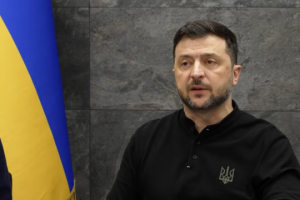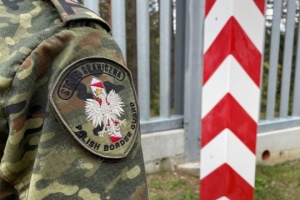
Twitter, YouTube and fringe sites: Russia keeps pushing propaganda in the West after TV outlets blocked
Strengthening of sanctions, massive withdrawal of foreign investors, withdrawal of capital, depreciation of assets — all of this hit the economy of Russia. The Ukrainian military made efforts to destroy the myth of the invincibility of the “second army of the world.” The closure of enterprises, the rise in prices and unemployment, the implementation of covert mobilization are not a complete list of challenges that Russia must overcome now. To convince the Russians that “everything is going according to plan,” a powerful propaganda machine helps the Kremlin, with plenty of petrodollars spent on its development in the last two decades. However, its units that worked for foreign audiences, primarily in Europe and North America, suffered serious losses.
Russian propaganda in the US, Canada, and the EU found it harder to work already in late February–early March. Due to sanctions and decisions of local regulators, RT America, RT UK, RT DE, and RT France TV channels were closed. Broadcasting of other RT channels, Sputnik news agency websites, which is also part of the Russia Today media holding, was blocked in many countries. EU users have been denied access to RT- and Sputnik-related YouTube channels. Owners of Android and iOS smartphones cannot install RT News and Sputnik News apps on their gadgets. They are currently unavailable on either the PlayMarket or AppStore outside of Russia.
In the countries of Central and South America, Asia, Africa, and the Middle East, the situation for Russia has not changed significantly. RT and subsidiary channels are broadcast there. RT en Español continues to work with the multi-million audience in Argentina, Venezuela, Nicaragua, Chile, Cuba, and elsewhere in the region, reinforcing anti-American, anti-Atlantic, and anti-Ukrainian sentiments. RT Arabic carries out similar activity promoting anti-Israeli narratives, as well as the parent English-language RT channel, which is broadcast via satellite.
After having its channels and news sites blocked, the Kremlin still has many channels to convey propaganda to the western audience. However, the Russians had to somewhat adjust their work with it.
The Centeк for Strategic Communication and Information Security tracked the key channels for the dissemination of pro-Kremlin narratives in the West.
Quoting in “White” Media
After the blocking of RT and Sputnik, they remain a source of news for Western media, as well as other Russian state resources: TASS and Ria Novosti news agencies, government websites, Twitter accounts of officials, government agencies, and diplomatic missions of Russia.
Quoting the statements by Russian government officials, politicians, and diplomats is used to inform the audience about the position and intentions of the Kremlin. Publications in high-quality media are usually accompanied by reminders of the aggression of Russia against Ukraine and an openly hostile policy towards the West. However, even in such cases, there are “fails,” in particular, the use of names of settlements in Russian, not Ukrainian transcription, or in general outdated names.
The re-publication of news from Russian sources without context is the dissemination of Kremlin narratives. Some online media, including Newsweek, re-publish translations of messages by Russian government agencies and news from Russian state news agencies.

Read more about this in the Centre’s study on Russian narratives in Western online media.
Television
Blocking of RT and subsidiary TV channels did not leave the Kremlin without channels to promote its narratives on Western television.
The co-owner of one of the largest European TV channels — Euronews — is VGTRK (All-Russia State TV and Radio Broadcasting Company). After a number of operations, the share of VGTRK Euronews decreased from almost 17% to 2.29%. However, the narratives of Kremlin propaganda are promoted not only by the Russian office of the broadcaster. In June 2022, the National Council of TV and Radio Broadcasting of Ukraine appealed to the leadership of Euronews to not only stop cooperation with the Russian office, but also to prevent the dissemination of Kremlin narratives by other offices. The National Council drew attention to the story about “Azot” in Sievierodonetsk, broadcast in French on June 12. There were no comments of official representatives of Ukraine in the piece. Instead, its authors let Leonid Pasechnik, head of the “LPR,” speak, who justified the Russian aggression against Ukraine.
Russian narratives are promoted by numerous “friends of Putin” from among Western politicians. Marin Le Pen periodically gives interviews and comments to BFM TV, RTL, France Inter, Euranet Plus, and other European TV and radio stations. The media’s interest in this person is growing during the presidential and parliamentary elections in France. Hungarian Prime Minister Viktor Orbán, given his status, also regularly appears on air.
American professor Charles Kupchan, who regularly calls on the West to “reckon with Russia” (at the expense of Ukraine’s security) on the pages of online and print media, does the same on television. He was one of the main speakers in the CBS Arming Ukraine film, which claimed that allegedly only 30% of Western aid reaches the front. Kupchan once again criticized Western military aid and shifted responsibility for the war to the NATO bloc, justifying the Kremlin.
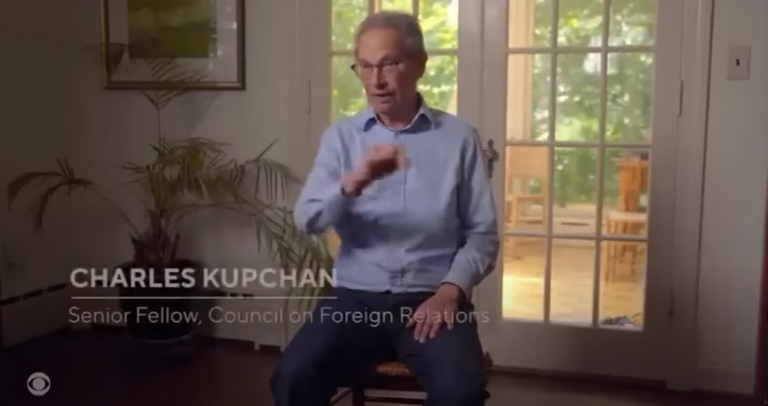
Pro-Kremlin narratives are promoted by the host and participants of the Tucker Carlson Tonight show, which airs on Fox News. Although Carlson’s show does not reflect the general information policy of the TV channel, and key leaders of the Republican Party of the United States do not appear there, the show has high ratings. In 2021, each episode had an average of more than 3 million viewers. Tucker Carlson uses the Ukrainian topic to criticize the Biden administration, resorting to rebroadcasting Russian propaganda. In particular, he talked about “American biolabs in Ukraine,” quoting statements by Russian and Chinese officials and accusing his own government of lying, criticizing the supply of weapons to Ukraine, anti-Russian sanctions, and claiming that the American authorities were responsible for the war.

Public agents of Russian influence, including well-known media personalities (filmmaker Oliver Stone, founder of Pink Floyd Roger Waters), politicians, dozens of political commentators and journalists not only appear on TV and radio and print materials in online publications — the most stable source of content they generate is their social networks and YouTube channels.
From time to time, international human rights organizations play into the hand of Russian propaganda. The most resonant case was the scandalous August report by Amnesty International. AI held the AFU responsible for exposing civilians to danger during hostilities in populated areas, ignoring the defensive nature of the war for Ukraine. Human Rights Watch reached a similar conclusion, equating the responsibility of the Ukrainian and Russian military. Propagandists, officials, and diplomats of Russia actively referred to the conclusions of human rights defenders as evidence of “war crimes” of the Armed Forces of Ukraine. The apparent imbalance of the Amnesty report triggered a sharp response from Ukraine, caused reputational damage, and caused a split in the organization. However, the management of the central office refused to admit the mistakes.
Social networks
On March 1, Meta blocked RT’s Facebook and Instagram pages. Restrictions are also imposed on the Zvezda TV channel and Sputnik news pages, but they are only valid in European countries. In the US, Canada, Australia, New Zealand, Africa, Asia, and Latin America, access to the pages is granted.
Kremlin propaganda on Facebook and Instagram is disseminated by Russian agents of influence, including those who collaborated or are collaborating with RT and other Russian media.

For Russian propaganda, Twitter is one of the key platforms for the distribution of its narratives and disinformation. The nature of this network, the audience, and the algorithms make it convenient for promoting political messages.
On March 2, the day of the UN General Assembly voting for the resolution “Aggression against Ukraine,” a massive publication of tweets with the hashtags #IStandWithRussiaand #IStandWithPutin was recorded. By March 9, nearly 10,000 accounts had shared at least one of these hashtags at least five times.
UK CASM Technology experts identified several message distribution clusters with these hashtags: Indian, Iranian-Pakistani, and African. Until February 24, account holders did not pay much attention to Ukraine. Another cluster was formed with accounts without geo-referencing, created on February 24 and March 2.
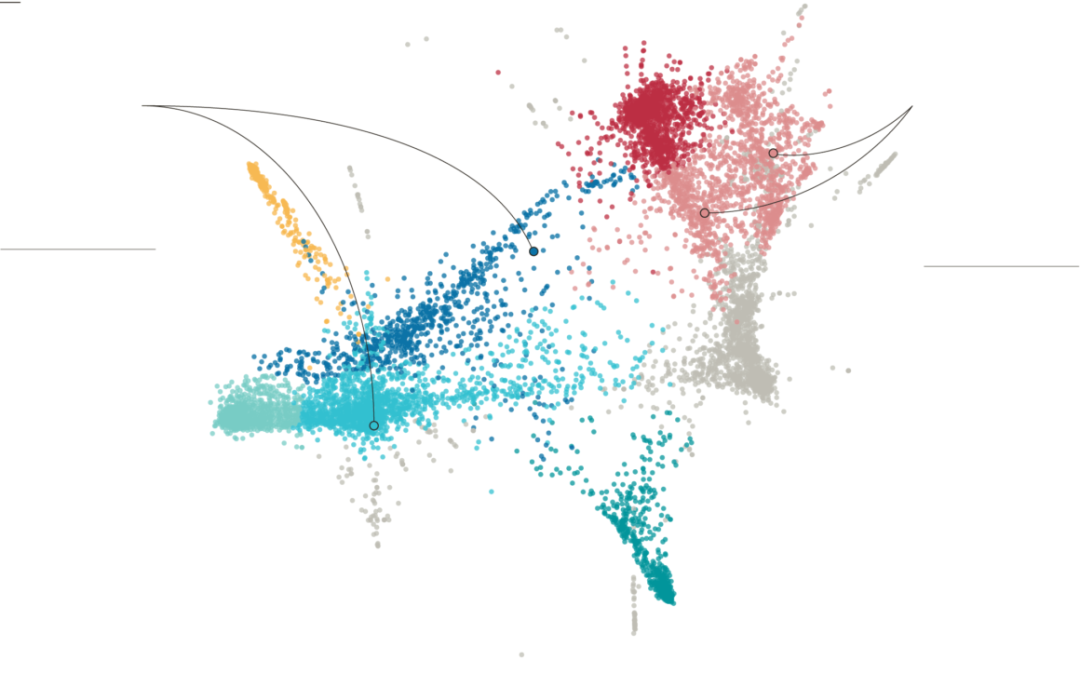
The publications were aimed at justifying the Russian invasion, discrediting Ukraine and the Armed Forces of Ukraine, and contained false information. Accounts were involved in the spread of manipulative memes with anti-Western and pro-Russian messages aimed at supporting Putin’s aggression.
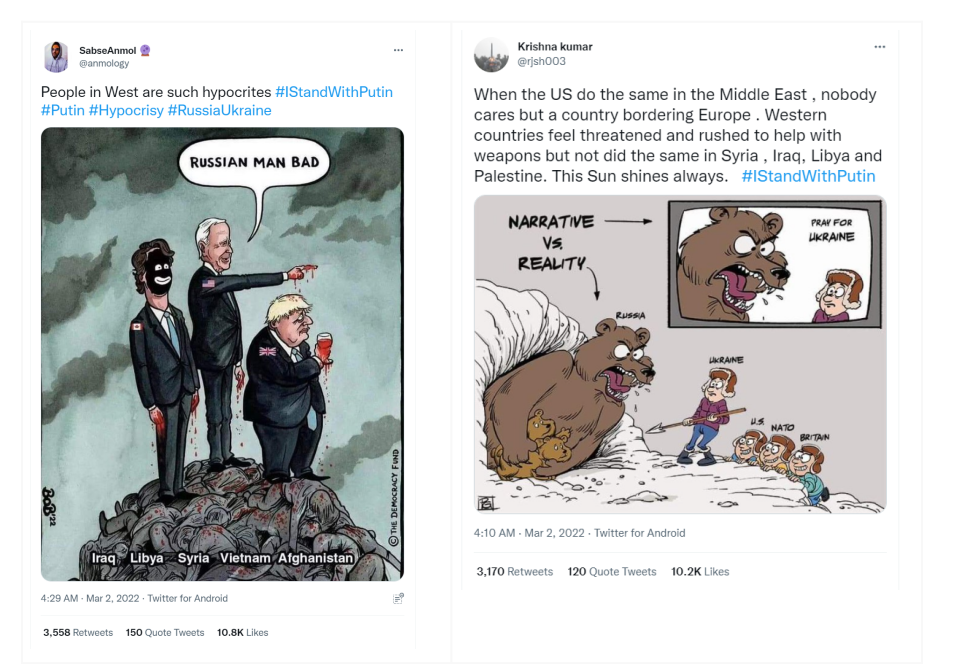
Analysts suggest that Russia or its agents are paying account holders in Asia and Africa to tweet. In addition, the Russians are actively using bot farms.
For the information support of the war against Ukraine, the Kremlin uses Twitter accounts of diplomatic and other government agencies. The authors of a study published in The Conversation found that during February 25-March 3 alone, of 75 government accounts, 1,157 tweets were posted, three-quarters of which justified the Russian invasion and contained false information about Ukraine. The total number of subscribers of these accounts is 7 million. In August, the English-language page of the Ministry of Foreign Affairs of Russia on Twitter was blocked for seven days for distributing a fake about “American biolabs in Ukraine.”

Twitter’s policy does not provide for censorship. At the same time, the social network tries to counter fakes, destructive narratives, and Russian propaganda in particular. In mid-March, 75,000 accounts and over 50,000 tweets were deleted. Accounts of RT, TASS, Sputnik, and other Russian state information agencies are marked as Russia state-affiliated media. The social network policy does not provide for promotion and recommendation of accounts and tweets of the media in this category to users. Since August 5, access to RIA Novosti and some of its subsidiaries has been blocked for users in the UK and EU countries.
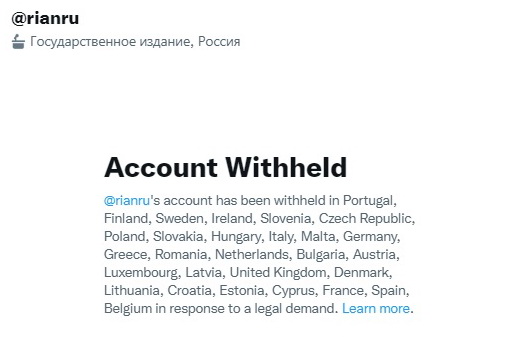
Despite this, the spread of Russian propaganda on Twitter continues. According to CASM Technology, more than 50% of accounts spreading Russian propaganda survived during the large-scale “purges”.
Russian narratives are systematically disseminated by accounts whose owners declare far-left communist or far-right views.
Despite the fact that Vkontakte was created as a Russian-language social network, today it is also used to spread Kremlin fakes and propaganda not only in Russia and in the post-Soviet space. According to SimilarWeb, Russian audience generates more than 80% of VK’s traffic, another 10% is accounted for by users from Belarus, Ukraine, and Kazakhstan. The remaining 10% are other countries of the world, with Germany and the USA in the lead. Foreign users other than Russian diaspora may be attracted to this network due to its “anti-system” nature and the absence of “imperialist censorship.” Proponents of conspiracy theories and anti-globalists are not deterred by numerous evidence of the social network’s cooperation with Russian special services and the children of Russian high-ranking officials in the positions of VK top managers.
Messages about “Ukrainian Nazis” and “Azov war crimes” in VK can be read in English, German, Spanish, French, Greek, Serbian and other languages. Individual accounts and language-based communities alike specialize in propaganda and disinformation. Many public agents of influence from the USA and European countries have active accounts on VK.

TikTok is also used by the Russians to spread propaganda both within Russia and abroad. Experts of the NewsGuard analytical project found out that as soon as in the first 40 minutes after registration, network algorithms give the new user videos with both truthful and fake information about the war in Ukraine. One of the most popular narratives identified by experts is “American biolaboratories in Ukraine.” Profound analysis of content published on TikTok is complicated because this Chinese social network is one of the least transparent in the world. Restrictions imposed on Russian users are avoided with the help of VPN services. TikTok houses in the Russian Federation and in the occupied territories are engaged in the creation of “patriotic” content.
In the West, Telegram is behind WhatsApp and Facebook Messenger in popularity. SimilarWeb and TGStat analytics show that Russia is the unequivocal leader in terms of the number of Telegram channels and their audience. The second and third places are shared by Iran and India. However, the number of Telegram users in Europe and North America is gradually increasing. French President Emmanuel Macron, Turkish President Recep Tayyip Erdoğan, Likud Party leader and former Israeli Prime Minister Benjamin Netanyahu and other politicians already have their own Telegram channels.
Given the rise in the messenger’s popularity, the Kremlin is using it to work with audiences in Europe and North America. Russian narratives in English, French, Spanish, German, and other European languages are promoted in the Telegram channels of the Russian Ministry of Foreign Affairs and other government institutions, state media (Sputnik, RT), channels of agents of influence and anonymous channels, some of which specialize in covering hostilities in Ukraine.
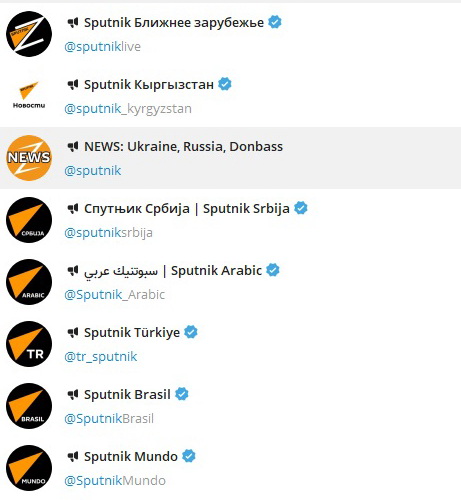
After RT America and RT UK editorial offices were closed in March, their Telegram channels stopped being updated. The RT News channel over 250,000 subscribers remains available to the English-speaking audience. RT France (almost 65,000 subscribers) and RT DE (55,000 subscribers) continue to function despite the closure of their TV counterparts. RT en Español (180 thousand subscribers) is aimed at residents of Central and South America.
The Chronicles of the Conflict Telegram channel, created on March 7, publishes messages from the Russian Ministry of Foreign Affairs, Ministry of Emergencies, Ministry of Defence, stories from the TV channels “Zvezda” and RT, and other propaganda materials, including fake news.

Publications from other English-language Telegram channels (UkrLeaks, DonbassDevushka, EarlGrey) and the channels of Eva Bartlett, Alina Lipp, Vittorio Rangeloni, Juan Cinimedo and other reporters working for Russian propaganda are also regularly shared. Since mid-May, all publications of the channel are in English; before that, they were also available in Russian.
YouTube
On March 1, YouTube channels RT and Sputnik were partially blocked. As with Facebook and Instagram, the restrictions only apply to users in Europe. In other parts of the world, the content of these Russian media remained accessible. There are users on YouTube who upload video recordings of RT programs to the hosting, which can be considered an attempt to circumvent restrictions. They also rapidly published the inaccurate CBS documentary Arming Ukraine, removed from the official YouTube channel. As expected, the “pirated” videos have a much lower reach than the ones published on the original channels.

Kremlin propaganda, in particular, briefings of the Russian Ministry of Defence, statements of Russian government officials and “L/DPR” militants, are also shared by YouTube channels ShanghaiEye and other Chinese media.
A number of channels created by users from the EU and the US are a platform for promoting Russian narratives on YouTube. Among them are channels created by former or current RT employees.
Far-left channels spread anti-Ukrainian propaganda as part of the fight against “American imperialism” and the promotion of pro-Kremlin and pro-Beijing narratives. This agenda is promoted by Multipolarista, Moderate Rebels, laborvideo, Historic_ly, International People’s Assembly and other similar channels.
The Multipolarista channel was created in 2017. As of mid-September, its author, Benjamin Norton, has published 146 videos: 137 in the last five months and only 19 in the previous five years. One in ten videos this year is dedicated to Ukraine.

Norton accuses the US and NATO of starting a “civil war 8 years before the Russian invasion,” claims that “Ukraine was sold to Western corporations” and talks about “Zelenskyy’s huge problems with Nazism.” Reflections on the “Ukrainian Nazis” and the “Ukrainian puppet government” are regularly broadcast on the Late Night with Lenin show on the Historic_ly channel.
Online Media
In addition to foreign-language versions of TASS websites and other Russian media, the Kremlin uses other resources to promote its narratives.
Project NewsGuard analysts have found that in the first four months since the beginning of the full-scale invasion alone, the number of websites disseminating disinformation about the Russian-Ukrainian war doubled: from 116 to 250. Among these resources, researchers discovered a group mimicking RT after the websites of this Russian state-owned outlet were blocked in European countries. The design of websites is identical to RT; they share RT’s materials, but their URLs are different from rt.com.
Each of these 250 websites disseminated at least one of the 54 Kremlin propaganda “myths” about the Russian-Ukrainian war identified by NewsGuard researchers. The most popular stories include “biolaboratories”, “staging” of mass killings of civilians in Bucha, “non-involvement” of Russians in the missile attack on Kramatorsk, etc. During the liberation of Kharkiv oblast from the Russian occupiers and the beginning of the exhumation of a mass grave in Izium, Scheerpost columnist Patrick Lawrence published an op-ed with a cynical title “Atrocity porn,” in which he questioned Russians’ involvement in the deaths of civilians.
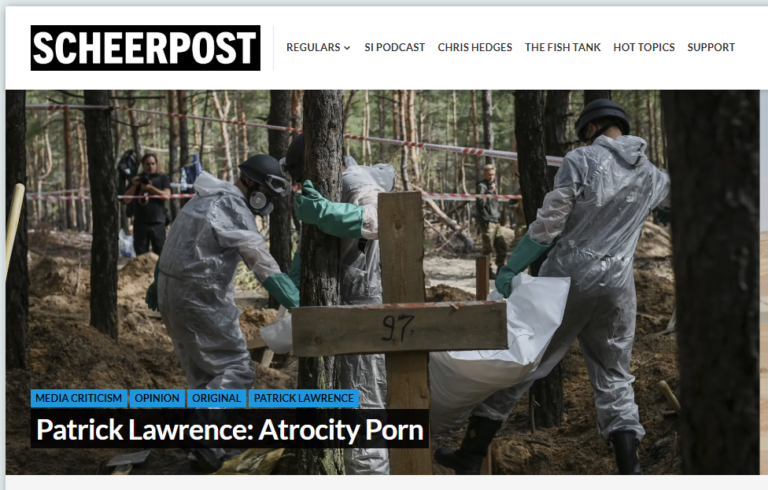
Disinformation and pro-Russian narratives are spread by English-language USSA News, AntiWar.com, German-language SNA, FAZ, Italian-language Contro Informazione, Vietato Parlare, and other sources. Some of them even use Telegram channels of Russian military personnel as sources of information. The far-left portal Multipolarista makes publications in Spanish and English and targets audiences in South, Central and North Americas.
The Saker Community group of websites deserves special attention. While the Ukrainian issue is not the main topic for the resources mentioned above, the websites of this group specialize mainly in anti-Ukrainian propaganda. The English-, Italian-, German-, Spanish-, Serbian-, and Russian-language versions of the website differ in content, but publications about “special operation” and “the fight against Ukrainian Nazism” occupy a prominent place. The Saker Community YouTube channel mainly publishes videos of the Russian propaganda resource “Politnavigator” with English subtitles.
Max Blumenthal, the founder of the website The Grayzone, has been systematically spreading the narrative about “Nazis” in Ukraine for several years, and in mid-April, he posted an extensive piece about the “persecution and killing of Zelenskyy’s opponents” by the “Nazis” and the SBU. Blumenthal’s co-author Esha Krishnaswamy (host of the Late Night with Lenin podcast) published an article in July about “child rapists released from prison by Zelenskyy” to “strengthen a depleted army.” The author completely faked the story, since former commander of the disbanded Tornado company Ruslan Onishchenko was released after serving his sentence, not on the President’s pardon.
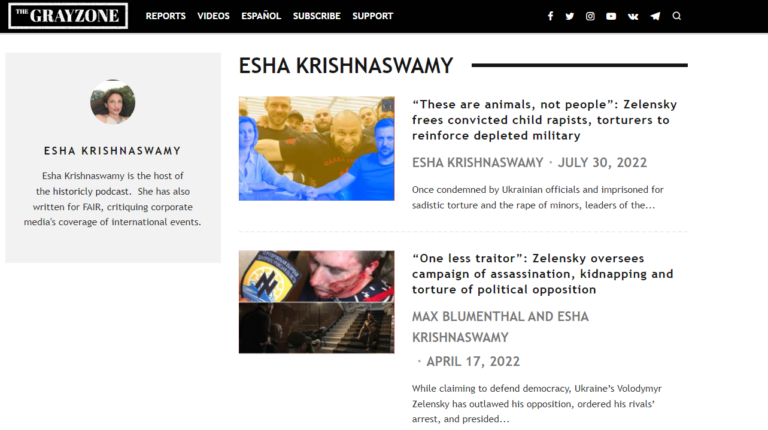
While propaganda tried to discredit the military, who were indeed released from pretrial detention centers to participate in the defense of Ukraine, a campaign was already underway in Russia to recruit prisoners of correctional colonies to the ranks of the Wagner PMC. Notably, The Grayzone has a page on the Russian social network VK.
The aforementioned websites position themselves as “independent” resources and “sources of alternative information” allegedly “hidden by mainstream media.” But the only alternative they can offer to the audience is fakes, manipulation and outright propaganda.
Thus, the restrictions imposed on Russian state media in Europe and North America did not deprive Kremlin propaganda of access to foreign audiences. Russian agents of influence regularly appear on the air of TV channels and radio and generate stories. Numerous analysts and commentators promote narratives beneficial to Russia in online media. Information websites of dubious quality are responsible for outright propaganda. Russian diplomats and their Twitter accounts became the drivers of disinformation and outright fakes. Conspiracy theorists and radical fighters against “American imperialism” have become allies of the Russian propaganda, failing to notice the imperialist nature of dictatorships.
Center for Strategic Communication and Information Security

